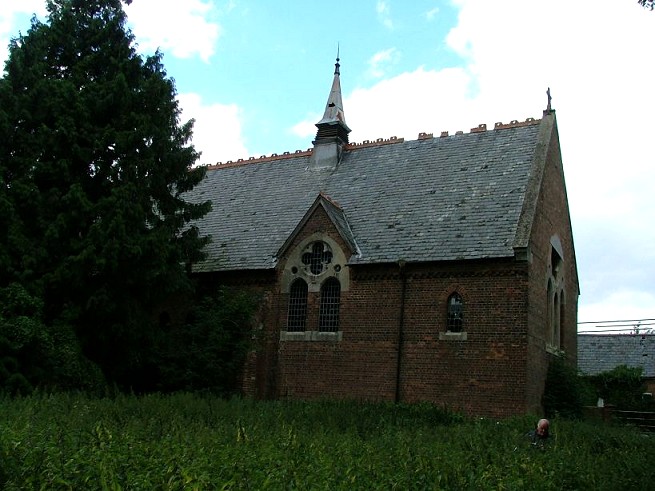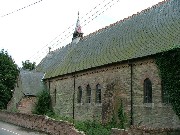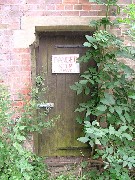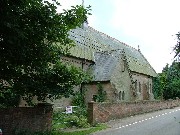| |
|
Holy
Trinity, Nordelph
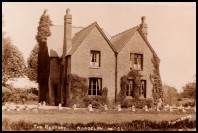 |
|
On
9th December, 1935, the poet John Betjeman wrote
in his private journal Nordelph is miles away
in the Norfolk fens, a village of two-storey
houses most of them sloping on unsafe foundations
strung about with telegraph poles and electric
light poles. Had inestimable privilege of
spending Sunday with the Reverend EE Bradford DD,
author of Passing the Love of Women and
many other volumes of verse. He has been Vicar of
Nordelph since 1917 and is now 75. A modernist,
but likes ritual. Last boyfriend called Edmund.
Not had a boyfriend for 30 years. V happy with
Nordelph. A Saint & thinks laws against
sexuality wicked cruel and out of date. Said the
Queen asked for one of his books. |
Obviously
a joke played on him poor old thing. Got his DD for
proving St Paul contradicts himself on the subject of
free will. Advocates birth control and says that
logically Onan is a must... should be permitted in public
schools. Service fairly well attended. Children get a
penny for coming, kept in little boxes in a draw of his
desk. Plays organ himself. Candles on red altar, black
cloths. All candles lighted. Sermon v abtruse and clever
on certainty of God. Talked of Julian Huxley. Cold supper
at the vicarage. Felt the better for seeing such a
saintly and sweet little man... Surely never did a bad
thing in his life.
| Holy
Trinity, Nordelph, is probably the most remote of
all Norfolk churches - St Mary at Welney is
further from other churches in the county, but
has near neighbours across the border in
Cambridgeshire. It is a lonely place today, and
must have seemed much more so in the 1930s.
Unusually, the name is Dutch, and the settlement
probably dates from the fen drainages of the 17th
century. The flat fens stretch all around, with
no other settlements in sight except,
incongruously, Downham Market like a golden city
on the hilltop miles away. Probably, Bradford's
long incumbency at Nordelph constituted a kind of
exile. |
|
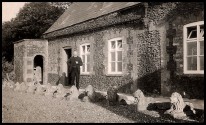 |
The large
church was commissioned by the Reverend William Townley,
and built in 1865 by the architect John Giles (Fletton
brick, fleche, nothing fancy - Pevsner), but today
it stands derelict and shrouded by the six feet high
nettles of the churchyard. It is not yet a ruin. Ron
Stannard's photograph, below to the right, shows the view
east inside shortly before the end.
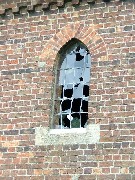 |
|
Some
derelict churches are romantic, but this one
isn't. It feels a sinister place. We fought our
way through the nettles, past the Keep Out
signs on the padlocked doors, to the graveyard.
On the far side, the windows were all smashed,
and the east window (excellent, by Heaton,
Butler & Bayne - Pevsner) boarded up,
the glass removed to storage. There are long
cracks running through the Fletton brick. All
about was a cold silence, except for wind from
across the fen, rustling nettles and shaking
hanging guttering. The Diocese
of Ely, in which Nordelph falls, badly wants to
demolish it. As building land, the graveyard is
worth a fortune. But there is one problem, and,
ironically, it is a problem that many working
churches would prefer not to suffer from. Holy
Trinity is home to several species of bats, and
bats are a protected species. And so, the church
is left to fall of its own accord.
|
Ron Stannard's photograph of the
interior, taken shortly before the church closed, shows a
bright, neat 19th century high church interior, with
light wood and devotional furnishings. All of this is now
lost forever.
| What
would the Reverend EE Bradford DD make of it all,
I wonder? To see him in the photograph above,
standing outside the village school across the
road from his church, he seems a fairly jolly,
solid sort. Back in the 1930s,
Betjeman's main memory of the vicarage was that
it was propped up because, like the other
buildings, it was sinking into the ground. When
they sat down to dinner, Bradford told Betjeman
"not to worry, old boy, we shall be quite
safe on this side of the house". So he was
not unfamiliar with dereliction.
He
would certainly seem to us to have stepped out of
another age. The greater part of his life was
lived in the Victorian era, and this was probably
what fascinated Betjeman more than Bradford's
poetry, which was generally mildly erotic verse
about boys. It's unlikely he would get away with
it today. However, Betjeman's friendship with him
was not entirely sincere, because Bradford was
the subject of numerous jokes between the future
poet laureate and his friends.
|
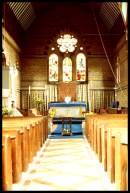 |
|
Betjeman's
biographer Bevis Hillier calls Bradford 'the paedophile
poet', which may be a little harsh, although it is true
that the final demise of the Vicarage came when Bradford
built a swimming pool beside the house so that he could
watch the local youths sporting in it.
 |
|
Villager
Chris Manning tells me that there are still
people alive in Nordelph today who remember
swimming in the pool. The pool was inspired
by a visit the Reverend Bradford had made to
Switzerland, Chris writes. On his
return, he got the village boys to dig out the
pond and use the soil to make
"mountains". He kept goats, and the
pond was surrounded by statues of lions, a few of
which can be found in local gardens! All
finished with now. Bradford and his vicarage have
long since returned to the earth, and no doubt
this church will soon join them*. A happier sight
is the former primitive methodist chapel down on
the main road, now converted into a house. You
can see it below.
|
Simon Knott, August 2005
| Postscript,
March 2006: Jane Crapnell writes My
great aunt was housekeeper for Dr. Bradford for
many years until his death. He left all his
property and wonderful belongings to her. He was
eccentric but well loved by the local people I
understand, and elderly people in Downham Market
and surrounding area remember him with affection.
He was once apprehended at Denver on the river
wall as being a suspect spy! My great aunt was
equally eccentric and let his house and
belongings rot. I have seven books of his poetry
published between 1908 and 1930 with his own
comments and remarks made by contemporary poets. Jane very
kindly lent the archive photos of Bradford's
Rectory and the man himself standing outside the
school, both above, along with the newspaper
cutting on the right reporting his death.
*December 2010: In 2009, the
Diocese of Ely applied for a demolition order
against Nordelph church, and in the Autumn of
2010 the church was demolished.
|
|
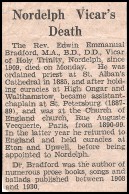 |
|
|
|

